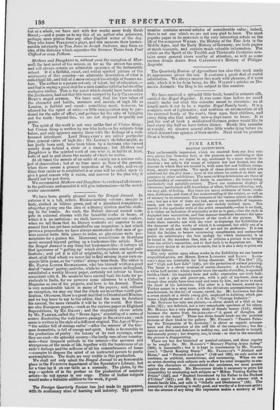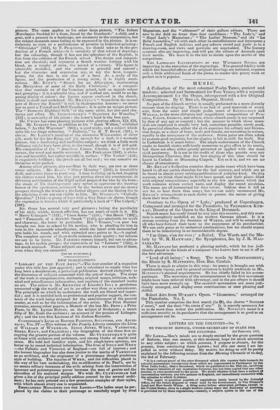FINE ARTS.
BRITISH INSTITUTION.
THE unfavourable impression which we received from our first cur- sory glance (on Saturday last) at the pictures now exhibiting at this Gallery, has been, we regret to say, confirmed by a more minute in- spection : not only is the range of subjects low and limited, but the manner in which they are treated is, with some few and brilliant excep- tions, merely respectable. We speak of those pictures only which are exhibited for thefiPst time ; most of the others we noticed on their ap- pearance in other exhibitions. The most striking deficiencies are those of intellectuality of conception and finish in execution ; the former being particularly and painfully evident. There' are numerous displays of cleverness, mechanical skill, knowledge of effect, brilliant colouring, and, we may add, of feeling. But there are many evidences of haste, crude- ness, feebleness, and want of due understanding of the subject, as well as of mastery in its treatment. The manners of the various artists are differ- ent; but not a few of them are bad, many are susceptible of improve- ment, and too many are peculiar and unduly insisted upon. Not merely is the particular style of the artist remarkable,—that is no fault, it is rather an indication of originality as far as it goes,—but the style is degraded into mannerism, and that manlier interferes between the spec- tator and nature, to the detriment of the truth of the picture. We make these remarks not with the view to disparage the Exhibition or the character of the works of which it is composed, but solely out of a regard for truth and the interests of art and its professors. It is too much the fashion to bestow unmeaning compliments and undeserved praise on exhibitions ; the best apology for which insincerity is to be found in the mistaken idea, that to criticise a picture is to detract from the artist's reputation, and to find fault is to depreciate art. We have every desire to do justice to merit, but it is also a duty to point out essential defects.
The only artists upon whose works in the Exhibition we can bestow unqualified praise, are Messrs. EDWIN LANDSEER and LANCE. LAND- SEER'S dogs are inimitable for living character. His "Too Hot" (2), and "High and Low Life" (248), are the perfection of animal painting. The latter is a clever contrast of canine character. A butcher's dog, a white bull terrier, whose muzzle bears the marks of conflict, is squatted beside a block his ungainly form and sulky expression are truly ludi- crous ; and a pipe and porter-pot, with a pair of top-boots, seem as though they might have been used and worn by him, and serve to mark the locale of his habitation. The other is a fine hound, seated on a Turkey carpet in a snug room, with the chivalrous accompaniments (an anachronism, by-the-by) of casque, sword, &c. Mr. LANDSEER has also a sweet sketch of a lovely young girl, employed in knitting, which pos- sesses a high degree of merit : it is No. 25, "Cottage Industry." Mr. NEWTON. has only one picture,—a clever sketch of a Girl at her toilet (37) ; not deficient, nor a very remarkable specimen of his talent. Mr. Boxam. has a very pleasing study of female beauty (151), which becomes the motto from SHAKSPEARE-" A guest of thoughts, all tenants to the heart." These last three female heads are the prettiest pictures of their kind in-the gallery. Mr. FRASER'S " Teniers Paint- ing the Temptation of St. Anthony," is clever as regards arrange- ment and the execution of the still life of the composition ; but the . figures are feeble and deficient in making out, and the female is insipid, and scarcely pretty; her drapery, too, is crude : so that in the essentials the picture is disappointing. There are but few historical or poetical subjects, and those require to be sought for. Mr. HAYDON'S "Mercury Playing Argus Asleep"
(303), is lamentable ; but it is kept in countenance by Mr. Noma.
coxs's "David Keeping Sheep." Mr. FRADELLE'S " Abelard and Eloise," and " Fetrarch and Laura" (149 and 160), we only notice to condemn, as artificial, meretricious, and unmeaning. When we see an artist choosing such subjects only to show his utter incapacity to con- ceive the characters or comprehend the sentiment, we must protest against the anomaly. Mr. BROCREDON thinks it necessary to prove his
incapability by attempting such subjects as " Milton Visiting Galileo in Prison" (542), and "Raphael Introduced by his Father to the Duchess
d'Urbino" (347) ; and Mr. EVANS paints a negro in armour with a female beside him, and calls it "Othello and Desdemona" (58). The execution of the painting is really good, and worthy of a first-rate artist; but the absence of any thing like expression makes a mockery of the picture. The same applies to his other large picture, "The Infant lEsculapius Suckled by a Goat, found by the Goatherd:" a child, and a -goat, and a peasant in a landscape, are necessary to the composition, but the subject demands some feeling to be expressed in the picture. It is sa- tisfactory to turn to a performance Of proniise in historical painting : " Otbryades" (312), by F. PICKERING, we should take to be the pro- duction of a French artist—it is certainly of that school of drawing; but the colouring, though it has not the splendour of the English, is free from the coldness of the French school. The design and composi- tion are classical ; and represent a Greek warrior writing with his blood, on a trophy of arms, the record of a victory. The figure is admirably modelled, and the attitude is graceful and natural ; but the character and expression are, to say the least, inappro- priate, for the face is not that . of a hero. As a study of the figure, and the production of a young artist, it is highly meri- torious. Mr. ETTY'S " Sketch for an Altar-piece, representing the Martyrdom of some of the Early Christians," is a composi- tion that reminds us of the Venetian school, both as regards colour and grouping : it is a splendid idefs, and if worked out, would be an im- posing display of colour: the figures appear confused in the sketch, which is small and undefined. Mr. HENNING'S " Scene from the second part of Henry the Fourth" is rich in Shakspearian humour: we never saw so good a Falstaff and Doll Tearsheet : it is quite an unique picture. The " Domestic Highland Still," of the same artist, has also good cha- racter and effect. Mr. EDMONSTONE'S " Departure for Waterloo," (337), is unworthy of his talent : the horse's head is the best part. Mr. Ltwefes has some pleasing pictures with glowing effects, 172, 178, 352. Mr. Lessner has, in addition to his " 'mak Walton," exhibited before, "An Old Warrener" (363) ; a good study, and a subject which suits his too dingy colouring. " Jealousy," by , R. T. BONE, (351), is clever. Mr. LANCE'S painting of the enormous Wine-cooler, of silver gilt, made for the late King, and big enough for a bath; is a masterly picture, but a lumbering and ineffective subject : we think -a little more brilliancy might have been given to the vessel, though it is of dull gold. His composition of the " American Canna, Citrons, &c.," is perfect nature, the wood and marble excepted. His Fruit-piece (353), is elabo- rate and beautiful, but rather metallic in surface. " The Casket" (489),
is exquisitely ; the jewels are all but real ; we can conceive no imitation more perfect. Among other pictures, also excellent in their way, are two or three comic subjects. Mr. Buss's " 13ittsr Morning" (302), is irresistibly droll, and comes home to every one. A man is sitting up in bed, hugging the clothes round him, his eyes just peering above the counterpane, in shivering anticipation of the frigid ordeal prepared for him by the frost : the steam of his shaving-water only serves to aggravate the freezing horror of the apartment, evidenced by the broken ewer and the snowy prospect through the window ; the furred slippers and the blazing fire in the adjoining room are not visible to him. Mr. WEBSTER'S " Catholic Question," (113)—a group of boys with a Guy Faux=is clever, though the expression is forced ; which is particularly a fault of "The Culprit," (106).
Mr. Goon has several very good pictures ; bating the peculiarity of his style, which, though effective, has too much of trick in it. His "Merry Cottagers "(121), "Coast Scene" (234), "Sea Beach "(297), and "Forecastle of a Berwick Smack" (546), are admirable for truth and character, the latter in particular. His " Truant,"—a poor boy brought too late to school by his mother, who is pleading for him in vain to the inexorable schoolmaster, while the latter with outstretched arm holds his watch, and with extended cane points to it,—is capital. .The complete success of these drolls redeems their quality ; but failures are not to be borne. Mr. FanniEic repeats himself, but not to advan- tage, in his urchin groups : the expression of his " Loiterer " (132), is too much strained. These subjects are overdone ; we soon tire of them, even when they are successful.
(TO BE RESUMED.)



























 Previous page
Previous page